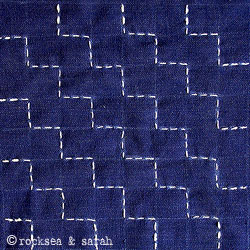Continued from Sashiko
Fabric, needle, and thread
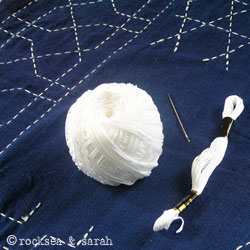 | Traditionally, Sashiko uses light-colored thread over darker shades of fabric. Again, the most popular shade was dark blue or indigo, and white cotton thread was used to work over it. These days, you can always experiment with the color shade of the fabric or thread to apply the Sashiko technique. |
The fabric used popularly was and still is cotton. Tightly woven even weave fabric can be good for Sashiko. These days, silk and wool are also catching up on popularity.
The Sashiko thread is made of pure cotton and has no sheen. It has a heavier look and is more twisted than the Perle cotton thread. If working on cotton fabric, the Sashiko thread can be replaced with Perle cotton (#5, preferably) or four strands of cotton floss. Of course, different fabrics would have different thread requirements. For instance, while working on silk, you might use lighter or thinner threads.
Traditionally, the Sashiko needle is almost 2 inches long with a small eye. This needle helps in taking many stitches at a time. It is best to avoid short needles as the stitching can become tiresome and time-consuming. Try to use a long needle with a comfortable open eye.
Stitching
 | 1. Keep the running stitches as even as possible. Any unevenness will easily be shown on the pattern. 2. The stitch on the front side of the fabric is more than the one under. The general ratio is 3:2. 3. Keeping the working thread at a length of 20 inches at a time. That will help in comfortable stitching. |
How to begin, continue, and end
Traditionally, Sashiko does not allow to start or end a stitch with a knot. But, for ease of it, we can use knots where the reverse of the fabric will not be used or shown. For fabrics where reverse will be shown, use the traditional method as following:
 | Consider that the stitch is worked from left to right. Note that the overlapping of the few stitches is what secures the thread. Try keeping the ends of the thread at teh reverse side of the fabric.Cut the ends of the thread as close as possible to the fabric to give a neat appearance. |
 |  |  |
| Beginning | Continuing with a stitch | Ending |
Making turns
1. When the designs are reversible, you need to keep the back as neat as possible. For this reason, you need to cut out the thread at every turn and hide it under the other threads. To achieve this, follow the same method as you would to begin or end a stitch traditionally. (Refer to the illustrations above).
2. When the reverse side of the fabric is hidden, you can turn using the same thread. You can carry the working thread at the back of the cloth if the distance is not more than an inch. Try to leave the carrying thread loose to avoid puckering of the fabric.
Corners and Centers
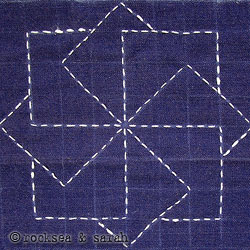 | The corners should be kept sharp. for this, one of the stitches should fall on the corner. That is, the needle should either come up or go in through the corner point. Any other effect other than what is shown in the illustration is wrong (See the different corners). The centers should be left open. It should look like as in this illustration. Anything apart from this is wrong. |
Sewing orders
Basically, Sashiko follows the following order of stitching. But, note that the stitching order depends on the design too. A stitch is to be kept continuous as far as possible.
 | 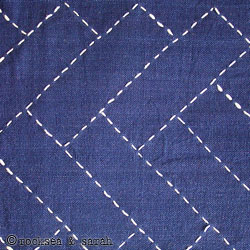 |  |
| 1. Horizontal & vertical lines | 2. Diagonal lines | 3. Curved lines |
Transferring of designs
There are a few ways in which the designs could be transferred to the cloth.
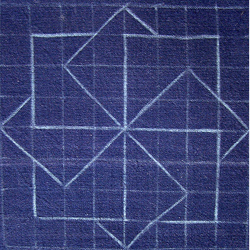 | 1. Use a transferring tool to draw the grids and pattern directly over the fabric. Learn about the different transferring tools and choose the one that suits you the best. 2. Draw or print the pattern on paper and transfer it to the fabric using a graphite sheet or a light box. Learn how to use the graphite sheet from my quick tutorial. |
Next, go to the other tutorials of Sashiko:


